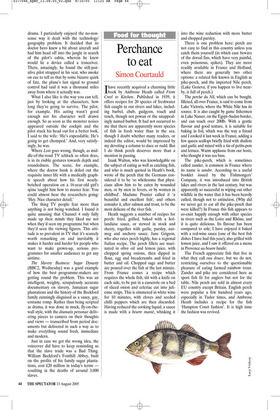Perchance to eat
Simon Courtauld
Ihave recently acquired a charming little book by Ambrose Heath called From Creel to Kitchen. Published in 1939, it offers recipes for 20 species of freshwater fish caught in our rivers and lakes, including barbel, chub, gudgeon, roach and tench, though not powan or the unappealingly named burbot. It had not occurred to me that there are apparently more species of fish in fresh water than in the sea, though I doubt whether many readers, or indeed the editor, would be impressed by my devoting a column to dace or rudd. But I do think perch deserves more than a mention in passing.
Izaak Walton, who was knowledgable on the subject of eating as well as catching fish, and who is much quoted in Heath’s book, wrote of the perch that the Germans considered it to be ‘so wholesome that physicians allow him to be eaten by wounded men, or by men in fevers, or by women in childbed’. Madame Prunier called it ‘a beautiful and excellent fish’, and others consider it, after salmon and trout, to be the most delicate of the river fish.
Heath suggests a number of recipes for perch: fried, grilled, baked with a hollandaise sauce, or stewed in stock and sherry, together with garlic, parsley, nutmeg and anchovy sauce. Jane Grigson, who also rates perch highly, has a regional Italian recipe. The perch fillets are marinated in olive oil and lemon juice, with chopped spring onions, then dipped in flour, egg and breadcrumbs and fried in butter and oil. Chopped sage and butter are poured over the fish at the last minute. From France comes a recipe which requires the whole fish, slit with a knife on each side, to be put in a casserole on a bed of sliced onion and celeriac cut into julienne strips. This is simmered in white wine for 10 minutes, with cloves and seeded chilli peppers which are then discarded. Having reduced the cooking liquid, a sauce is made with a beurre manié, whisking it into the wine reduction with more butter and chopped parsley.
There is one problem here: perch are not easy to find in this country unless you catch them yourself (in which case beware of the dorsal fins, which have very painful, even poisonous, spikes). They are more readily available in France and Holland, where there are generally two other options: a related fish known in English as pike-perch, and the imported Nile perch. (Lake Geneva, if you happen to live nearby, is full of perch.) The perche du Nil, which can be bought, filleted, all over France, is said to come from Lake Victoria, where the White Nile has its source. It is also caught by game fishermen in Lake Nasser, on the Egypt–Sudan border, and can reach over 200lb. With a gentle flavour and good texture, it is suitable for baking in foil, which was the way a friend and I cooked it last week in France, adding a few queen scallops briefly fried with shallots and garlic and mixed with a tin of petits-pois and lettuce. Warm applause from our hosts, who thought it was sea bass.
The pike-perch, which is sometimes called zander, is common in France where its name is sandre. According to a useful booklet issued by the Fishmongers’ Company, it was introduced into British lakes and rivers in the last century, but was apparently so successful in wiping out other wildlife in the water that it has been heavily culled, though not to extinction. (Why did we never get to eat all the pike-perch that were killed?) In France this fish appears to co-exist happily enough with other species in rivers such as the Loire and Rhône, and it is quite delicious. Its flavour has been compared to sole; I have enjoyed it baked with a red-wine sauce (one of the best fish dishes I have had this year), also grilled with lemon juice, and I saw it offered on a menu in Provence au beurre basilic.
The French appreciate fish that live in what they call eau douce, but we do not, restricting ourselves to the questionable pleasure of eating farmed rainbow trout. Zander and pike are considered here as sport fish fit for anglers but not for the table. Nile perch are sold in almost every EU country except Britain. English perch were popular a few hundred years ago, especially in Tudor times, and Ambrose Heath includes a recipe for the fish ‘Hampton Court fashion’. It is high time the fashion was revived.











































 Previous page
Previous page